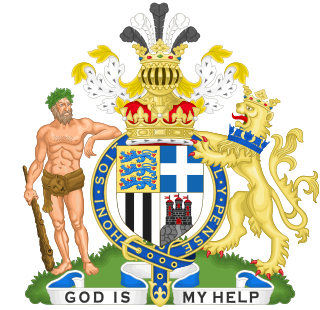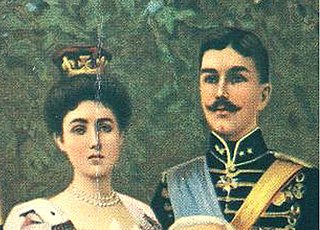
Duke of Edinburgh, named after the city of Edinburgh, Scotland, is a substantive title that has been created three times for members of the British royal family since 1726. The current holder is Prince Philip, husband of Queen Elizabeth II.

Duke of York is a title of nobility in the Peerage of the United Kingdom. Since the 15th century, it has, when granted, usually been given to the second son of English monarchs. The equivalent title in the Scottish peerage was Duke of Albany. However, King George I and Queen Victoria granted the second sons of their eldest sons the titles Duke of York and Albany and Duke of York respectively.

Duke of Gloucester is a British royal title, often conferred on one of the sons of the reigning monarch. The first four creations were in the Peerage of England and the last in the Peerage of the United Kingdom; the current creation carries with it the subsidiary titles of Earl of Ulster and Baron Culloden.

Duke of Rothesay is a dynastic title of the heir apparent to the British throne, currently Prince Charles. It was a title of the heir apparent to the throne of the Kingdom of Scotland before 1707, of the Kingdom of Great Britain from 1707 to 1801, and now of the United Kingdom of Great Britain and Northern Ireland. It is the title mandated for use by the heir apparent when in Scotland, in preference to the titles Duke of Cornwall and Prince of Wales, which are used in the rest of the United Kingdom and overseas. The Duke of Rothesay also holds other Scottish titles, including those of Earl of Carrick, Baron of Renfrew, Lord of the Isles and Prince and Great Steward of Scotland. The title is named after Rothesay on the Isle of Bute, Argyll and Bute, but is not associated with any legal entity or landed property, unlike the Duchy of Cornwall.

The title of Duke of Connaught and Strathearn was granted by Queen Victoria of the United Kingdom of Great Britain and Ireland to her third son, Prince Arthur, on 24 May 1874. At the same time, he was also granted the subsidiary title of Earl of Sussex.

Duke of Westminster is a title in the Peerage of the United Kingdom. It was created by Queen Victoria in 1874 and bestowed upon Hugh Grosvenor, 3rd Marquess of Westminster. It is the most recent dukedom conferred on someone not related to the British royal family.
Duke of Buckingham, referring to Buckingham, is a title that has been created several times in the peerages of England, Great Britain, and the United Kingdom. There have also been Earls of Buckingham and Marquesses of Buckingham.

Duke of Cambridge, one of the six current royal dukedoms in the United Kingdom, is a hereditary title of specific rank of nobility in the British royal family. The title is hereditary among male agnatic descendants of the titleholder by primogeniture, and has been conferred upon members of the British royal family several times. The wife of the titleholder is usually called the Duchess of Cambridge.
Earl of Norfolk is a title which has been created several times in the Peerage of England. Created in 1070, the first major dynasty to hold the title was the 12th and 13th century Bigod family, and it then was later held by the Mowbrays, who were also made Dukes of Norfolk. Due to the Bigods' descent in the female line from William Marshal, they inherited the hereditary office of Earl Marshal, still held by the Dukes of Norfolk today. The present title was created in 1644 for Thomas Howard, 18th Earl of Arundel, the heir of the Howard Dukedom of Norfolk which had been forfeit in 1572. Arundel's grandson, the 20th Earl of Arundel and 3rd Earl of Norfolk, was restored to the Dukedom as 5th Duke upon the Restoration in 1660, and the title continues to be borne by the Dukes of Norfolk.

Duke of Hamilton is a title in the Peerage of Scotland, created in 1643. It is the senior dukedom in that Peerage, and as such its holder is the Premier Peer of Scotland, as well as being head of both the House of Hamilton and the House of Douglas. The title, the town of Hamilton in Lanarkshire, and many places around the world are named after members of the Hamilton family. The Ducal family's surname, originally "Hamilton", is now "Douglas-Hamilton". Since 1711, the Dukedom has been held together with the Dukedom of Brandon in the Peerage of Great Britain, and the Dukes since that time have been styled Duke of Hamilton and Brandon, along with several other subsidiary titles.

The title Duke of Buccleuch, formerly also spelt Duke of Buccleugh, is a title in the Peerage of Scotland created twice on 20 April 1663, first for James Scott, 1st Duke of Monmouth and second suo jure for his wife Anne Scott, 4th Countess of Buccleuch. Monmouth, the eldest illegitimate son of Charles II was attainted after his 1685 rebellion, but his wife's title was unaffected and passed on to their descendants, who have successively borne the surnames Scott, Montagu-Scott, Montagu Douglas Scott and Scott again. In 1810, the 3rd Duke of Buccleuch inherited the Dukedom of Queensberry, also in the Peerage of Scotland, thus separating that title from the Marquessate of Queensberry.

Duke of Richmond is a title in the Peerage of England that has been created four times in British history. It has been held by members of the royal Tudor and Stuart families.

The title Duke of Lennox has been created several times in the Peerage of Scotland, for Clan Stewart of Darnley. The Dukedom, named for the district of Lennox in Stirling, was first created in 1581, and had formerly been the Earldom of Lennox. The second Duke was made Duke of Richmond; at his death, the dukedom of Richmond became extinct. The fourth Duke of Lennox was also created Duke of Richmond; at the death of the sixth Duke, both the dukedoms became extinct. The Dukedom of Richmond and one month later that of Lennox were created in 1675 for Charles Lennox, an illegitimate son of Charles II. The Duke of Richmond and Lennox was created Duke of Gordon in 1876. Thus, the Duke holds four dukedoms, more than any other person in the realm.

Duke of Cleveland is a title that has been created twice, once in the Peerage of England and once in the Peerage of the United Kingdom. The dukedoms were named after Cleveland in northern England.

Duke of York and Albany was a title of nobility in the Peerage of Great Britain. The title was created three times during the 18th century and was usually given to the second son of British monarchs. The predecessor titles in the English and Scottish peerages were Duke of York and Duke of Albany.

Duke of Viseu was a Portuguese Royal Dukedom created in 1415 by King John I of Portugal for his third male child, Henry the Navigator, following the conquest of Ceuta.
In the British peerage, a royal duke is a member of the British royal family, entitled to the titular dignity of prince and the style of His Royal Highness, who holds a dukedom. Dukedoms are the highest titles in the British roll of peerage, and the holders of these particular dukedoms are Princes of the Blood Royal. The holders of the dukedoms are royal, not the titles themselves. They are titles created and bestowed on legitimate sons and male-line grandsons of the British monarch, usually upon reaching their majority or marriage. The titles can be inherited but cease to be called "royal" once they pass beyond the grandsons of a monarch. As with any peerage, once the title becomes extinct, it may subsequently be recreated by the reigning monarch at any time.













